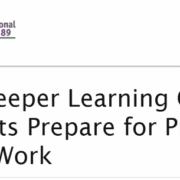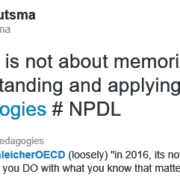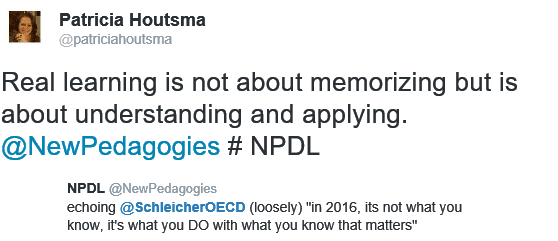Today we continue to feature contributors from our global partnership.
 Patrick Miller is the Principal of Innovation with the Simcoe County District School Board in Ontario, Canada. He leads a team of Program and Innovation Instructional Resource Teachers who support innovative learning and teaching strategies across the district K-12. He works to connect learners to each other and to education thinkers around the globe. Patrick also serves as a support to the Canadian Cluster of New Pedagogies for Deep Learning. You can connect with Pat on twitter via @millerpEDU
Patrick Miller is the Principal of Innovation with the Simcoe County District School Board in Ontario, Canada. He leads a team of Program and Innovation Instructional Resource Teachers who support innovative learning and teaching strategies across the district K-12. He works to connect learners to each other and to education thinkers around the globe. Patrick also serves as a support to the Canadian Cluster of New Pedagogies for Deep Learning. You can connect with Pat on twitter via @millerpEDU
Pat shares his thoughts about engagement, empowerment and life long learning.
I was speaking to a group of teacher candidates recently, and asked them to finish the sentence,  “I want the students in my class to be…”. I captured their responses in this word cloud. No surprise that engaged was by far the most popular answer (as well as one person who just wanted them to be alive).
“I want the students in my class to be…”. I captured their responses in this word cloud. No surprise that engaged was by far the most popular answer (as well as one person who just wanted them to be alive).
Generally, people agree that it is a good thing that students are engaged while they are with us. But not every busy student or quiet class is engaged. Sometimes, engagement is just compliance with a smile. When we talk about engagement, we are often describing students thinking about and acting upon our ideas, our curriculum, our world. In that sense, engagement isn’t good enough! When pressed for what is it that is more impactful than engagement, we usually come to empowerment. Empowerment happens when students think about and act upon their ideas, their interests, their world.
 However, empowerment, like so many things, is determined by the receiver, not the giver. You may think you have empowered students, but if they don’t feel it, then they aren’t really empowered. I wrote a post about this called Staff Empowerment and Other Superpowers where I talked about staff empowerment, but I believe the statement below holds true for student empowerment as well.
However, empowerment, like so many things, is determined by the receiver, not the giver. You may think you have empowered students, but if they don’t feel it, then they aren’t really empowered. I wrote a post about this called Staff Empowerment and Other Superpowers where I talked about staff empowerment, but I believe the statement below holds true for student empowerment as well.
“Not only do you need to set the conditions and culture for empowerment, you also need to help them believe they are empowered. It doesn’t work if you don’t have both. A staff whose leader would gladly have them demonstrate initiative but never communicates that to them is left disenfranchised. A staff who believe they are empowered but don’t have any real self-determination is delusional.”
Empowerment requires genuine learning partnerships between and among students, staff and the wider school community. These partnerships enable and support all the benefits of co-authoring of the pedagogical practices, co-construction of the learning environment and co-curating of the digital tools which can accelerate student learning and make student thinking visible. While co-ownership of the learning is the goal, it should be made clear that real learner agency comes with all the perks and responsibility of ownership. Learners are responsible to their peers, staff, community and most importantly, themselves to be motivated, autonomous learners and contributing global citizens.
We have our students for a relatively short time in their overall life. What happens when they leave us? There is a long and hallowed tradition of wanting to prepare our students for the future and to impart the “truth”. The trouble is that in 5 years, 2 years or even next month, that truth and its context may have changed and these young people will not be equipped to discover the new truth.  While we can’t fully prepare our students for some unknown future or impart an unchanging and definitive truth, we can set in motion a life of learning. Our role is to generate learning momentum so when students leave our classrooms at the end of the day, our schools at the end of the year, and districts at the end of grade 12, they carry on learning.
While we can’t fully prepare our students for some unknown future or impart an unchanging and definitive truth, we can set in motion a life of learning. Our role is to generate learning momentum so when students leave our classrooms at the end of the day, our schools at the end of the year, and districts at the end of grade 12, they carry on learning.
We all need that learning momentum. As educators, the learning never stops. To me, best practices suggests an end point. We need to be sure to stop and celebrate these practices and success or people will complain that you keep moving the bar. But then, we must press on. When people say “We just learned that, now you want us to learn this? Make up your mind.” I think, “This is our best new thinking. How can you learn something new about your practice and not use it? This video, Better Starts Now is a great example of what we could miss out on if people see best practice or success as an end and not a beginning of something better. We keep iterating – not because we are not good enough, but because we can be even better. Who doesn’t want to be better for our students?
One of my favorite interview questions is “What is your best new learning?” You get a good sense of the candidate as a learner from how they respond. If you ever get asked that question, please don’t start your response with, “Last year I attended a …”




 Patrick Miller
Patrick Miller “I want the students in my class to be…”. I captured their responses in this word cloud. No surprise that engaged was by far the most popular answer (as well as one person who just wanted them to be alive).
“I want the students in my class to be…”. I captured their responses in this word cloud. No surprise that engaged was by far the most popular answer (as well as one person who just wanted them to be alive). However, empowerment, like so many things, is determined by the receiver, not the giver. You may think you have empowered students, but if they don’t feel it, then they aren’t really empowered. I wrote a post about this called
However, empowerment, like so many things, is determined by the receiver, not the giver. You may think you have empowered students, but if they don’t feel it, then they aren’t really empowered. I wrote a post about this called  While we can’t fully prepare our students for some unknown future or impart an unchanging and definitive truth, we can set in motion a life of learning. Our role is to generate learning momentum so when students leave our classrooms at the end of the day, our schools at the end of the year, and districts at the end of grade 12, they carry on learning.
While we can’t fully prepare our students for some unknown future or impart an unchanging and definitive truth, we can set in motion a life of learning. Our role is to generate learning momentum so when students leave our classrooms at the end of the day, our schools at the end of the year, and districts at the end of grade 12, they carry on learning.








 It is with a great deal of pleasure that we welcome you to
It is with a great deal of pleasure that we welcome you to 

